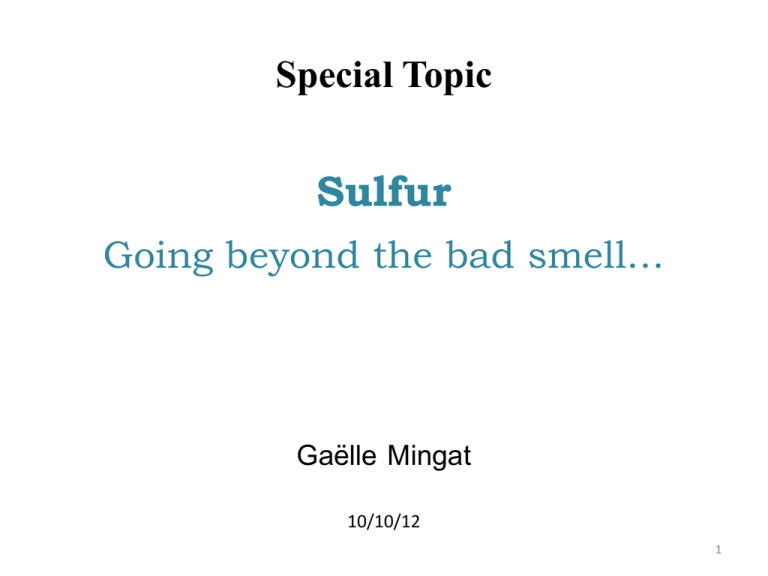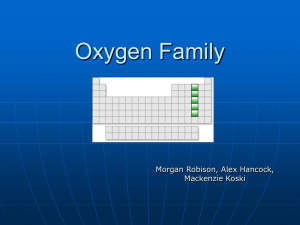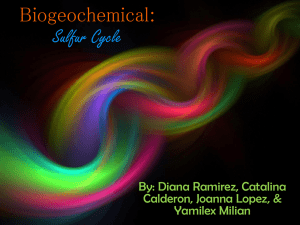Special Topic Sulfur..
advertisement

Special Topic Sulfur Going beyond the bad smell… Gaëlle Mingat 10/10/12 1 Sulfur, going beyond the bad smell… Overview I. General properties II. Some name reactions involving sulfur III. Sulfur ylides and the Corey-Chaykovsky reaction IV. Chiral sulfur V. Sulfur migration in organic synthesis VI. Sulfur in the food industry VII. A « bad smell » example, just one… VIII. Sulfur in perfumes 10/10/12 2 I. General properties - abundant, multivalent non-metal - cyclic octatomic molecule: S8 - Found in nature as the pure element, sulfide (S2-) and sulfate (SO42-) minerals - Either an oxidant or a reducing agent Bright yellow solid Melting point: 115.21 °C, blood-red liquid Burns with a blue flame better observed in the3 dark I. General properties - Once extracted from salt domes: Frasch process → 99.5% pure melted product - Today produced as a by-product by removing organosulfur compounds from natural gas and petroleum Carrying sulfur blocks from a volcano, Indonesia Hydrodesulfurization R-S-R + 2H2 → 2 R-H + H2S Conversion of hydrogen sulfide in elemental sulfur via the Claus process 3 O2 + 2 H2S → 2 SO2 + 2 H2O SO2 + 2 H2S → 3 S + 2 H2O Stockpiles of elemental sulfur recovered from hydrocarbons, Alberta, Canada World production in 2011: 69 M tones → China (9.6), US (8.8), Canada (7.1), Russia (7.1) Dibenzothiophene, a composant of crude oil 4 I. General properties Electronic configurations: 6C 1s2 2s2 2p2 8O 1s2 2s2 2p4 16S 1s2 2s2 2p6 3s2 3p4 O: r = 70.2 pm S: r = 104.9 pm C-O: 355-380 kJ/mol C-S: 255 kJ/mol C=O: 678 kJ/mol C=S: 377 kJ/mol Longer and weaker bond Weaker π bond (bad overlap) Schaumann E.; Top Curr. Chem. 2007, 274:1-34 (DOI 10.1007/128_2006_105) 5 I. General properties Electronegativities → electron affinities, ionization potentials, bond energies Sanderson: «compactness » of an atom’s electron cloud → Polarizability of S C-S bond: polarization not pronounced Ionic character lessened as compared to oxygen counterparts (hydrogen bonding less important) Aromaticity: furan (Eres = 75kJ/mol) < thiophene < benzene (Eres = 113 kJ/mol) Schaumann E.; Top Curr. Chem. 2007, 274:1-34 (DOI 10.1007/128_2006_105) 6 I. General properties Cysteine Essential element for life Methionine Glutathione : antioxydant (Cysteine/Glycine/Glutamate) Disulfide bonds : mechanical strength, insolubility of keratin (hair, outer skin, feathers) and pungent odor when burned Thioester acetyl coenzyme A Cystine (dehydrogenated cysteine) 7 I. General properties Biotin (vitamin H) Essential element for life Penicillin core structure Thiamine (vitamin B1) Umpolung chemistry in nature « S-adenosylmethionine »: Nature’s iodomethane or diazomethane equivalent Sulfanilamide (sulfa drug) 8 I. General properties Thiols: R-SH Important chemical functionalities Sulfides: R-S-R Sulfoxides Sulfones Sulfonic acids Sulfimides Sulfoximides Sulfonediimides Sulfonamides (sulfa drugs) Sulfinic acids Sulfinamides Sulfenic acids Sulfenamides Thiocarbonyls: thioamides 9 I. General properties S-nitrosothiols Important chemical functionalities Thiocyanates Isothiocyanates Sulfines [R3S]+ Sulfonium, oxosulfonium ion Sulfonium, oxosulfonium ylide 10 II. Some name reactions involving sulfur - Lawesson’s reagent: from a ketone to a thioketone → Enones, esters, lactones, amides, lactams, quinones - Sulfur as a reducing agent → NaHSO3, Na2SO3, Na2S2O3, Na2S·9H2O, SOCl2, SO2... → Me2S in ozonolysis to prevent further oxidation of products (still used??) - Oxidation reactions → Pfitzner-Moffatt ▫ urea byproducts difficult to remove → Swern ▫ better yields, fewer side products than P-M → Corey-Kim ▫ T > -25°C allowed but Me2S (toxic + bad smell) 11 Kürti L., Czako B.; Strategic Applications of Named Reactions in Organic Synthesis (2005) II. Some name reactions involving sulfur - Oxidation reactions → Davis’ oxaziridine oxidations ▫ 2-arylsulfonyl-3-aryloxaziridines ▫ sulfides and selenides to sulfoxides and selenoxides ▫ alkenes to epoxides ▫ amines to hydroxylamines and amine oxides ▫ organometallic compounds to alcohols and phenols ▫ most widespread application: oxidation of enolates to α-hydroxy carbonyl compounds (acyloins) 12 Kürti L., Czako B.; Strategic Applications of Named Reactions in Organic Synthesis (2005) II. Some name reactions involving sulfur - Olefinations → Bamford Stevens ▫ aprotic solvents: Z-alkenes major / protic solvents: mixture of E- and Z-alkenes → Shapiro → Corey-Winter → Julia-Lythgoe ▫ E-alkenes major 13 Kürti L., Czako B.; Strategic Applications of Named Reactions in Organic Synthesis (2005) II. Some name reactions involving sulfur - Rearrangements → Mislow-Evans → Pummerer → Ramberg-Bäcklund → Stevens ▫ 1,2-rearrangement of a sulfonium salt giving a sulfide, using a strong base 14 Kürti L., Czako B.; Strategic Applications of Named Reactions in Organic Synthesis (2005) II. Some name reactions involving sulfur → Barton-McCombie radical deoxygenation reaction ▫ radical substitution via a thiocarbonyl → Burgess dehydration reaction → Chugaev elimination reaction ▫ alkenes from alcohols via a xanthate undergoing a syn-elimination → Corey-Nicolaou macrolactonization 15 Kürti L., Czako B.; Strategic Applications of Named Reactions in Organic Synthesis (2005) III. Sulfur ylides and the Corey-Chaykovsky reaction Schaumann E.; Top Curr. Chem. 2007, 274:1-34 (DOI 10.1007/128_2006_105) 16 III. Sulfur ylides and the Corey-Chaykovsky reaction Corey-Chaykovsky reaction: JACS 1965, 87 (6), 1353 Schaumann E.; Top Curr. Chem. 2007, 274:1-34 (DOI 10.1007/128_2006_105) 17 III. Sulfur ylides and the Corey-Chaykovsky reaction Enantio- and diastereocontrol in sulfur ylides-mediated epoxidations: Aggarwal’s work Schaumann E.; Top Curr. Chem. 2007, 274:1-34 (DOI 10.1007/128_2006_105) Aggarwal V.; Chem. Commun. 2003, 2644 18 III. Sulfur ylides and the Corey-Chaykovsky reaction Examples of sulfur ylides mediated asymmetric epoxidations Schaumann E.; Top Curr. Chem. 2007, 274:1-34 (DOI 10.1007/128_2006_105) Aggarwal V.; Chem. Commun. 2003, 2644 19 III. Sulfur ylides and the Corey-Chaykovsky reaction The example of stabilized ylides (additional anion-stabilizing group): trans-diastereoselectivity Cross-over experiments: Either anti- or syn-sulfonium salt furnishes only the trans-epoxide containing the more reactive aldehyde (p-NO2C6H4) → both syn- and anti-betaine are formed reversibly Trans-selectivity because barrier to torsional rotation in anti-betaine smaller 20 Aggarwal V.; Chem. Commun. 2003, 2644 III. Sulfur ylides and the Corey-Chaykovsky reaction Semi-stabilized ylides: trans-diastereoselectivity Cross-over experiments: Anti-betaine reacted with a more reactive aldehyde: no incorporation of this aldehyde in the final epoxide With syn-betaine: complete incorporation of the more reactive aldehyde → Anti-betaine irreversibly formed → Syn-betaine reversibly formed 21 Aggarwal V.; Chem. Commun. 2003, 2644 III. Sulfur ylides and the Corey-Chaykovsky reaction Control of enantioselectivity 1) 2) 3) 4) Formation of a single diastereoisomeric sulfonium ylide High level of control of ylide conformation High level of control in face selectivity of the ylide Non-reversibility of the anti-betaine formation 22 Aggarwal V.; Chem. Commun. 2003, 2644 III. Sulfur ylides and the Corey-Chaykovsky reaction Control of enantioselectivity: effect of protic solvents Aggarwal If low enantioselectivity: Protic solvents or addition of Li cations makes the reaction less reversible (if reversibility of betaine formation is the cause) If low diastereoselectivity: Aprotic solvents and avoidance of species capable of solvating alkoxides (increase of rotation barrier so reaction more reversible – displacement equilibrium to left) 23 Aggarwal V.; Chem. Commun. 2003, 2644 IV. Chiral sulfur 24 Schaumann E.; Top Curr. Chem. 2007, 274:1-34 (DOI 10.1007/128_2006_105) IV. Chiral sulfur 25 Schaumann E.; Top Curr. Chem. 2007, 274:1-34 (DOI 10.1007/128_2006_105) IV. Chiral sulfur 26 Schaumann E.; Top Curr. Chem. 2007, 274:1-34 (DOI 10.1007/128_2006_105) IV. Chiral sulfur http://www.chemtube3d.com/Oppolzer.html 27 Schaumann E.; Top Curr. Chem. 2007, 274:1-34 (DOI 10.1007/128_2006_105) IV. Chiral sulfur 28 Schaumann E.; Top Curr. Chem. 2007, 274:1-34 (DOI 10.1007/128_2006_105) V. Sulfur migration in organic synthesis Stuart Warren’s work; preliminary observation 29 Warren S.; Phosphorous, Sulfur and Silicon 1999, 153-154, 59 V. Sulfur migration in organic synthesis D. House, S. Warren: stereospecificity in the migration of « SPh » Secondary OH = LG Primary OH = Nu Secondary OH = LG Primary OH no more a Nu 30 Warren S.; Phosphorous, Sulfur and Silicon 1999, 153-154, 59 V. Sulfur migration in organic synthesis Competition between 2 hydroxyl groups Is it possible to control which OH leaves, which acts as a Nu and where it attacks?? Primary OH = LG SPh = Nu Primary OH = LG Secondary OH = Nu 31 Warren S.; Phosphorous, Sulfur and Silicon 1999, 153-154, 59 V. Sulfur migration in organic synthesis Kinetic resolution of racemic and enolisable 2-PhS aldehydes 32 Warren S.; Phosphorous, Sulfur and Silicon 1999, 153-154, 59 VI. Sulfur in the food industry About 10% of the volatile components detected in foods and beverages contain sulfur Volatile organic sulfur compounds: extremely low odour threshold 33 → highly important for flavours and aromas Goeke A.; Sulfur reports 2002, 23, 3, 243 VI. Sulfur in the food industry The Maillard reactions (1911) ▫ chemical reactions occuring while cooking food ▫ amino acids + sugars form a brownish mixture when heated to high temperature ▫ responsible for many colors and flavors in foods: - the browning of various meats like steak - toasted bread, burnished crust of brioche, cakes, yeast, biscuits - French fries, fried onions - malted barley (whiskey, beer) - dried or condensed milk (dulce de leche) - maple syrup - roasted coffee ▫ importance for the food industry in order to control the aspect, the taste and the conservation of food (incorrect preparation or storage produce off-flavours) 34 VI. Sulfur in the food industry Role of cysteine and cysteine-S conjugates as odour precursors Maillard reaction: cysteine + sugars (meat flavour…) Roast meat Popcorn Basmati rice Cheddar cheese: methanethiol, hydrogen sulfide, dimethyl disulfide, dimethyl trisulfide → products of the catabolism of methionine and cysteine by bacteria 35 Starkenmann C.; Flavour Fragr. J. 2008, 23, 369 VI. Sulfur in the food industry Role of cysteine and cysteine-S conjugates as odour precursors Wine and passion fruit Wine treated with copper sulfate → « boxtree » and « tropical fruit » odours disappeared Passion fruit aroma Aroma of young botrytized sweet wines Cysteinylated precursors to typical aroma of Sauvignon wines 36 Starkenmann C.; Flavour Fragr. J. 2008, 23, 369 VI. Sulfur in the food industry Sulfur compounds in wine → 5 families: thiols, sulfides, polysulfides, thioesters, heterocycles → 2 categories: boiling point below or above 90 °C (volatile compounds or less) → Produced by 2 main processes: enzymatic: degradation of sulfur-containing amino-acids fermentation metabolism of sulfur-containing pesticides non-enzymatic: photochemical, thermal, chemical reactions during winemaking and storage → Role of SO2: antibiotic and antioxydant (« contains sulfites »; up to 10mg/L) → Reactions most studied: those catalyzed by light and producing unpleasant flavours called « light tastes » or « reduced tastes » 37 Guasch J.; J. Chromath. A 2000, 881, 569 VI. Sulfur in the food industry 38 Guasch J.; J. Chromath. A 2000, 881, 569 VI. Sulfur in the food industry 39 VI. Sulfur in the food industry 40 VI. Sulfur in the food industry Sulfur compounds in wine In general, aromatic contributions of the above compounds considered detrimental to wine quality → cabbage, garlic, onion, rubber… Some sulfur compounds contribute actively and are typical to some wine aromas → strawberry → box tree → passion fruit → cooked leeks 41 Guasch J.; J. Chromath. A 2000, 881, 569 VII. A « bad smell » example, just one… → Human sweat Sweat secreted by axillary glands odourless: odoriferous components generated by skin bacteria A tertiary thiol… 42 Starkenmann C.; Flavour Fragr. J. 2008, 23, 369 VIII. Sulfur in perfumes - Sulfur-containing compounds: some of the strongest odorants - Perception of odor often depends on: → chemical, diastereo- and enantio-purity → concentration (unpleasent odor when smelled at high concentration) ▫ ability to trigger different receptor sites in the olfactory bulb of the nose The cassis/cat example: 4-mercapto-4-methylpentanone 29 > 0.001%: obnoxious tom-cat urine off-odor (0.4% impurity in paint) < 0.00001%: natural crisp cassis note (Sauvignon wines) Also « Baie rouge » scent (raspberry), box tree, broom, green tea, grapefruit 43 Goeke A.; Sulfur reports 2002, 23, 3, 243 VIII. Sulfur in perfumes Structure-odor correlations Free tertiary sulfur group distant of 2-4 Å of a carbonyl Importance of steric bulk around sulfur group (tertiary mercapto ketones) Importance of H bonding 61: no fruity odor 62: less cassis-like than 63 44 Goeke A.; Sulfur reports 2002, 23, 3, 243 VIII. Sulfur in perfumes Importance of diastereo- and enantio- purity Hydrolysis of thioacetates in the mucosa of the olfactory bulb responsible for cassis odor in 38? 45 Goeke A.; Sulfur reports 2002, 23, 3, 243 VIII. Sulfur in perfumes Grapefruit 1982: 1-p-menthene-8-thiol shown to be an extremely potent constituent of grapefruit juice. Also identified in orange, yuzu and must. 46 VIII. Sulfur in perfumes Passionfruit Oxane® (perfumery) 62, 63: also in white and red wines 47 Goeke A.; Sulfur reports 2002, 23, 3, 243 VIII. Sulfur in perfumes Green scents Fancy « tomato leaves » scent in the perfume « Les Belles » (Nina Ricci): complex combination of several odorants. Essential oil of coriander, used in fine fragrances: « Gucci No. 1 », « Le Jardin d’Amour », « Coriandre » (!) 48 Goeke A.; Sulfur reports 2002, 23, 3, 243 VIII. Sulfur in perfumes Scents of flowers 49 Goeke A.; Sulfur reports 2002, 23, 3, 243 VIII. Sulfur in perfumes The archetypal example: rose oil Impart naturalness of rose scent perceived when smelling rose petals to essential rose oil 50 Goeke A.; Sulfur reports 2002, 23, 3, 243 VIII. Sulfur in perfumes Musk odors - macrocyclic lactones and ketones: core structures found in natural isolates (muscone, ambrettolide, pentadecanolide) - quality of musk odor and intensity depends on: ▫ a subtle equilibrium of the ring size and geometry with hydrophobic parts and hydrogen-bond acceptors ▫ position of sulfur atom / carbonyls (6.9 Å between acceptor sides) even-nb ring: 1,7-distance 51 odd-nb ring: 1,6-distance Goeke A.; Sulfur reports 2002, 23, 3, 243 VIII. Sulfur in perfumes Sweet scents - sweet, caramel-like odor - generally cyclic dicarbonyl molecule - planar enol-carbonyl acts as a H-donor/H-acceptor pair of 3 Å distance at the olfactory receptor site Maltol No significant change Bark of larch trees Roasted barley Pines, wines Furaneol® Only minor changes → Structure of bifunctional unit important (not its chemical character: O vs S) Goeke A.; Sulfur reports 2002, 23, 3, 243 52 Thank you for your attention! 53







